
Steve Jobs was a red, Michael Jackson was a yellow. Barack Obama is undeniably green and Albert Einstein was obviously blue.
Do these two sentences sound like a nonsense to you?
Let me explain.
For a manager, it is his responsibility to ensure a good working atmosphere within his team.
But how do you ensure that the different personality types in your team are properly managed?
The DISC personality test allows you to simply identify the behavioural profiles of each member of your team.
By offering this personality questionnaire, your teams will be able to adapt their management practices to the needs of each individual and create an atmosphere conducive to communication, understanding and teamwork.
In this article, you will find the essentials you need to know about the DISC test:
The DISC personality test: a proven method
In 1928, the American psychologist William Moulton Marston published his book Emotions of Normal People in which he distinguished four main categories of behavioural profile.
It is these four components that will later form the disc used in the DISC personality test.
Today, the DISC test is published by the company TTI Sucess Insights.
For almost a century, these categories have been refined and clarified, but have not really evolved, proving the accuracy of William Moulton Marston’s analysis.
The DISC method is used in a variety of situations: in management in order to understand the personalities present in one’s team, to train sales advisors in order to understand the personalities of their prospects, in training in order to help employees develop professionally, etc.
The DISC method: the language of colours
The DISC colour personality test aims to reveal how we function in the face of events.
And how an employee, a client or a partner finds motivation, energy and solutions to the problems they encounter.
Through a series of quick and simple questions, a profile is identified. The result of the questionnaire is then presented in the form of a circle divided into quarters
Each quarter of this circle corresponds to a profile:
- The upper left-hand quarter corresponds to the Dominant profile coloured in red
- The upper right quarter corresponds to the Influential profile coloured in yellow
- The lower right quarter corresponds to the Stable profile coloured green
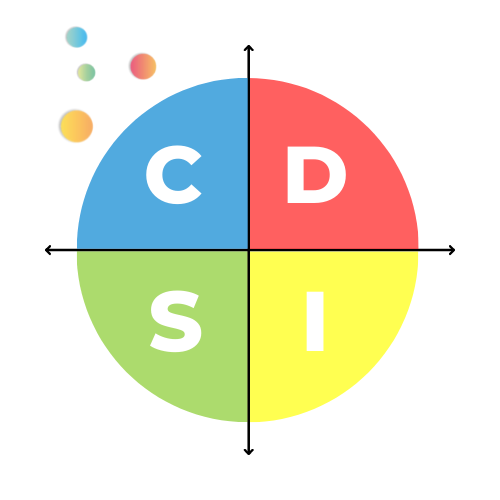
- The lower left quarter corresponds to the Conscientious profile coloured blue
The analysis of the personality test allows us to place the person tested in the circle according to his or her profile.
These four profiles correspond to the individual’s main personality trait, but the nuances in the answers make it possible to refine the profile, which will then be positioned more in the centre of a neighbourhood or near the intersection of two profiles, for example.
This simple psychological test allows managers to better understand the profiles and personalities of each of their employees in order to know how to better communicate with them.
DISC profiles
Each profile has its strengths and weaknesses, its qualities and faults. It is important for a leader to master these elements in order to adapt to each employee and to each situation.
The DISC test, which some people dare to call the “4-colour personality test”, can be used to improve team cohesion, easily integrate a new member, avoid the appearance of tensions, etc.
Let’s take a closer look at these 4 profiles.
DISC Red Profile: the Dominant
Let’s start with the colour red.
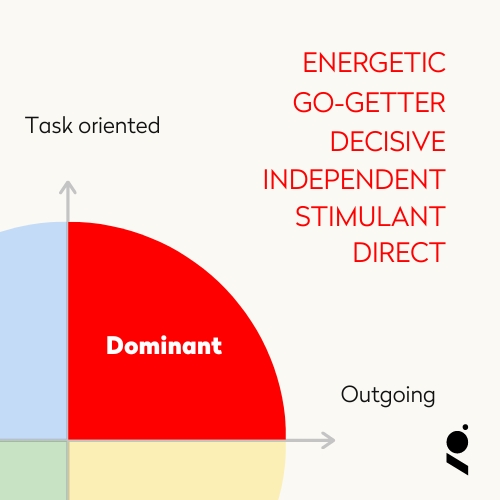
The dominant person has a global vision of the task to be accomplished and aims at the objective and the final result. To achieve this, they are able to take on challenges and responsibilities with the success of all in mind.
As a leader, they drive their team forward.
Extraverted, the dominant person knows how to assert himself, is frank, knows how to make himself heard and goes straight to the point?
In order to achieve their objectives, they are nevertheless capable of being inflexible and impatient, and are not always an attentive listener to their colleagues, to whom they can easily cut them off.
The dominant is a go-getter who is not afraid to make mistakes, which he usually takes responsibility for.
Their enthusiasm and need for action can sometimes be perceived as aggression. He can be quickly annoyed if things don’t go fast enough, for example, and his outspokenness can be misinterpreted and create tension with other team members.
DISC Yellow Profile : the Influencer
The second colour of the circle is yellow.
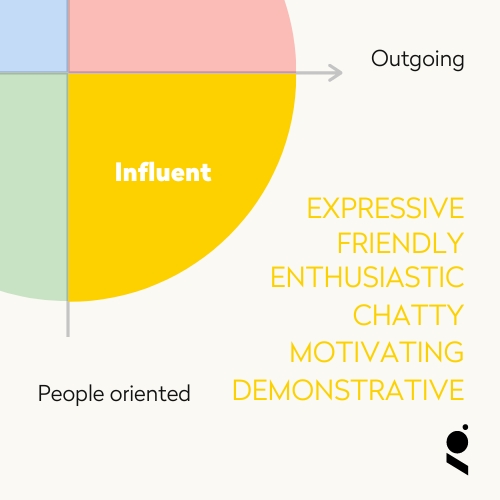
The influential person brings enthusiasm, good humour and motivation to the team. A social animal par excellence, the influential person is at ease with everyone and likes to work in a team.
Some would even say that the “influential” personality tends to delegate too much of the tasks given to them.
They are also keen to learn new things and to develop their skills, and are passionate about many subjects.
They may therefore sometimes abandon the file they have already started too quickly and quickly lose focus?
Influencers enjoy the company of others and like to feel they are the centre of attention. In order to feel good and valued in his work, he will always appreciate encouragement and compliments from his manager.
DISC Green Profile : the Stable
Green is the third colour of the circle.
Naturally calm and measured, the green or stable profile thinks above all about the well-being of those with whom it works.
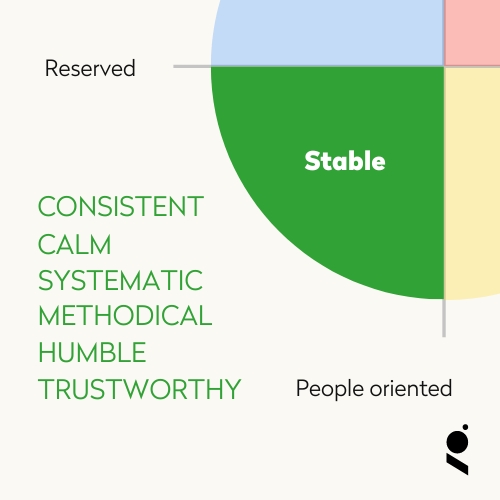
They believe that it is up to them to adapt to their environment and not the other way around. Therefore, the stable is a person who prefers to stay in the background, but will never refuse to help a colleague.
They are always present and willing to give advice. They may not talk much, but they are known as someone whose opinion counts and who is listened to.
Stable think before they act and do not like to be stressed. If pressure is too great, they may feel harassed and feel very bad about the situation, although they may not dare to talk about it.
Sensitive, the stable avoids conflict, which sometimes causes him to take it too far for too long.
When they explode, this does not go unnoticed and is not without consequences. This is why it is important to be attentive to the emotions of the stable and not to leave misunderstandings unresolved.
DISC Blue Profile : the Conscientious
And the last colour is blue.
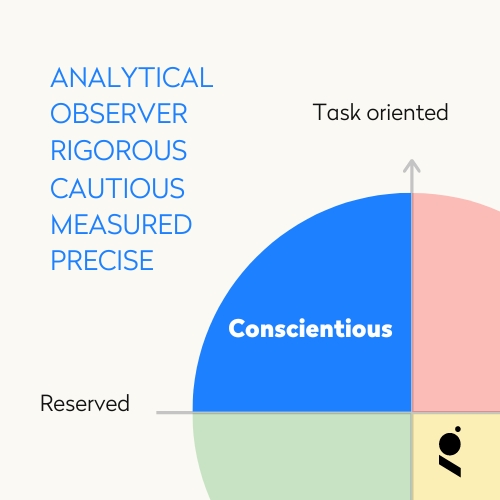
The conscientious person likes things to be done by the book.
Methodical, orderly and fastidious, they are thoughtful, self-reliant and can identify operational problems at a glance.
They know what they have to do and carry out their tasks without depending on anyone.
The conscientious person is reserved, focuses on his work more than on his colleagues, and enjoys working alone. This does not mean that they are not team players, on the contrary.

He is reliable and his team can rely on him and his skills?
But as soon as a doubt appears, the conscientious person can be afraid of making a mistake and does not dare to take a decision if he does not have all the information in hand.
A stickler for detail, the conscientious person can sometimes fall into perfectionism and waste time where it is not necessarily necessary.
********
The DISC personality assessment questionnaire or colour personality test is a useful and effective tool for proposing advanced management paths. When properly used, accompanied by engaging individual coaching, it helps to grow and to deploy a support for one’s teams adapted to each situation.
Would you like to take the DISC model personality test for targeted management? You can easily find a free Disc Colour Personality Test to take online.
It generally takes no more than a few minutes to answer the questions and obtain the summary of the DISC personality test pdf.
Be careful, however, to make sure that the reading of the results is usable for your colour DISC test.
🚨 We recommend using a certified TTI trainer coach in order to achieve a complete and actionable debrief 🚨
You can also choose to make your own DISC personality test template by finding out how to analyse the answers to the sample questions.
********
However, in a personality test such as the DISC test, it is important to be accompanied by a debriefing with a certified coach.
Do not hesitate to contact us for training and personality assessments like the DISC test.











